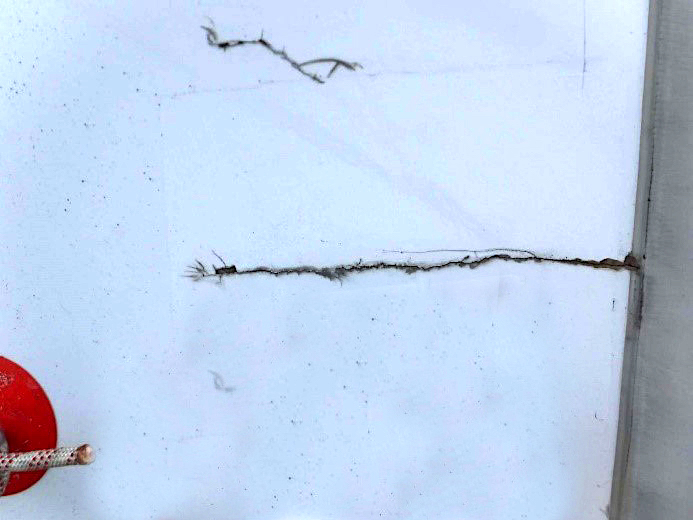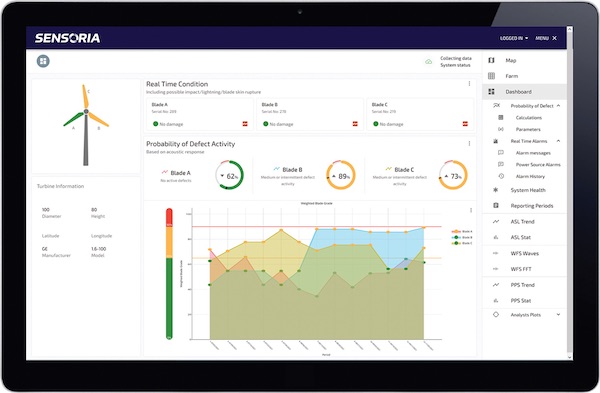The Sound of Success in the Wind Industry
Wind energy continues to be a pivotal player in the global shift towards sustainable power sources. As the wind industry advances, so does the need for efficient and reliable methods to monitor the health of wind turbine components, with a particular focus on the critical components such as the blades. Acoustic Emission (AE) monitoring, a proven technique with a successful track record in various industrial sectors, is emerging as a promising solution for continuous and remote wind blade health monitoring. Its adaptation for wind turbine applications highlights the distinct advantages it holds over competing monitoring technologies, including traditional vibration monitors.
Proven success in diverse industries
Acoustic Emission monitoring has been used for decades on a variety of critical civil and private assets in the infrastructure, oil and gas, renewable and non-renewable power, and manufacturing industries. This success is attributed to AE's ability to capture the acoustic waves emitted by active defects, such as cracks and delaminations, long before they become visible or critical.
The use of AE for remote structural health monitoring (SHM) of bridges is particularly relevant for its applicability to wind turbine blades. As at-height assets exposed to wind, rain, and other harsh environmental factors, bridges require regular inspections to ensure safety, but shutting bridges down for manned inspections is often not an option as commuters rely on them daily. AE sensors have been used for decades to monitor for cracking, fatigue, and microfracture damage to alert operators to potential concerns, enabling them to plan inspection and maintenance outages for optimal times while avoiding unplanned downtime.
From monitoring pressure vessels in petrochemical plants to assessing the structural integrity of buildings and pipelines, AE has demonstrated its sensitivity to early-stage damage detection. This successful track record has naturally sparked interest in transferring the benefits of AE monitoring to the wind energy sector.

Acoustic Emission monitoring is proven to detect blade damages, including cracking and delaminations, earlier than traditional inspection methods.
AE in wind blade monitoring
Wind turbine blades are subjected to a harsh and dynamic operating environment, with factors such as wind loads, turbulence, and varying temperatures placing constant stress on the structures. Monitoring the health of these blades is crucial to prevent catastrophic failures and optimize maintenance strategies. Acoustic Emission monitoring has emerged as a reliable technique for assessing the structural integrity of wind turbine blades throughout their operational life.
One of the key advantages of AE monitoring in wind blade applications is its ability to detect and locate defects in real time. As blades experience fatigue, encounter environmental stresses, or suffer impacts, they emit acoustic signals that AE sensors can capture. This early detection capability allows for proactive maintenance interventions, reducing downtime and the risk of costly repairs.
Advantages over traditional techniques
While traditional inspections and certain monitoring techniques (such as vibration testing) have been used to evaluate wind blade integrity, AE monitoring brings several unique advantages to the table that make it a safer, more cost-effective option.
- Early Detection of Damage: AE excels in detecting the initiation and propagation of cracks, corrosion, and other damages, providing an early warning system that is quicker than traditional manned inspections and more accurate than remote vibration monitors. This early detection capability significantly reduces the risk of unexpected failures.
- Broad Frequency Range: AE monitoring captures a wide range of frequencies, allowing it to detect and characterize various types of damage-related events. This versatility ensures that no critical information is missed, providing a more comprehensive picture of the blade's health compared to vibration sensors, which may have limitations in frequency coverage.
- Environmental Adaptability: Wind turbine installations are exposed to diverse environmental conditions. AE monitoring is less affected by factors such as temperature variations and wind speed fluctuations, ensuring consistent performance in challenging outdoor environments where vibration sensors may face limitations.
- Reduced False Alarms: AE technology is known for its ability to distinguish between genuine damage-related signals and background noise, leading to fewer false alarms. This specificity is crucial for efficient and reliable monitoring, especially in remote and inaccessible locations where false alarms can result in unnecessary travel and maintenance activities.
- Identification of Specific Defects: AE monitoring provides valuable information about the location and type of defects within the blade structure. This detailed insight allows maintenance teams to prioritize and plan repair activities more effectively than vibration monitoring, which may provide less specific information.
- Long-Term Trend Analysis: AE technology's capability to track the progression of damage over time facilitates predictive maintenance strategies. This long-term trend analysis is a valuable tool for optimizing maintenance schedules and planning for the eventual replacement of blades.
- Cost-Effectiveness: While the initial installation costs of AE systems may be higher than those of vibration monitoring, the long-term cost-effectiveness is often superior. The ability to prevent costly blade failures and unplanned downtime justifies the initial investment, making AE a financially prudent choice over time.

Recent AE monitoring innovative technology enables operators to view the condition of their blades in real time through a web-based portal.
Shifting from reactive to proactive
Acoustic Emission monitoring has traversed the boundaries of infrastructure, petrochemical, and structural engineering, proving itself a reliable and sensitive technique for damage detection. As the wind energy sector continues to expand, the application of AE monitoring to wind turbine blades offers a paradigm shift in the approach to blade health assessment. The unique advantages of early detection, environmental adaptability, and specificity in defect identification position AE monitoring as a superior choice compared to traditional integrity assessment techniques, including vibration monitoring. By embracing AE technology, the wind industry can enhance the reliability and longevity of its turbine blades, contributing to the overall sustainability and efficiency of wind energy generation.
Author is Valery Godinez-Azcuaga is Director of MISTRAS Group’s Sensoria Center of Excellence. MISTRAS is a "one source" multinational provider of integrated technology-enabled asset protection solutions, helping to maximize the safety and operational uptime for civilization’s most critical industrial and civil assets.
Sensoria by MISTRAS | www.sensoria.com
Author: Valery Godinez-Azcuaga
Volume: 2024 January/February




.jpg?r=5406)





.jpg?r=6467)

